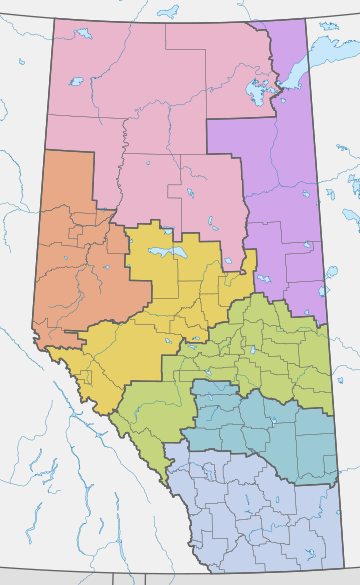Land-use framework regions of Alberta
Land-use framework regions are a scheme of organizing local governments adopted by the Canadian province of Alberta. Numbering seven in total, each land-use region is named for, and roughly follows the boundary of, a major watershed. Managed by Alberta Environment and Parks, the stated aims of the program are to create a venue for regionwide planning and cooperation, promoting sustainable use of public and private lands. Every region is intended to develop and enact its own comprehensive regional land-use plan, guiding future development within its territory. However, as of 2019, approved plans have only been submitted from two of the seven regions.[1]
| Land-use framework regions | |
|---|---|
| Location | Alberta |
| Created | 2007 |
| Number | 7 |
| Populations | 37,759 (Lower Peace) – 1,814,190 (South Saskatchewan) |
| Areas | 50,338 km2 (Red Deer) – 192,198 km2 (Lower Peace) |
History
Land-use planning has been practiced in various forms by the Alberta government for more than a century. In 1948, the Manning government divided the province into a 'green' and 'white' area. The 'Green Area', comprising 61% of Alberta's landmass and mostly owned by the provincial government, was to be managed for forest production, wildlife management, and recreation. The 'White Area', comprising the remaining 39%, was designated for settlement and agriculture. Further plans, some regional in scope, were implemented over the next few decades. For instance, the 1977 Policy for Resource Management of the Eastern Slopes identified watershed protection and public recreation as higher priorities than non-renewable resource development in Alberta's Rocky Mountain Foothills. However, these were implemented on a case-by-case basis, and never achieved comprehensive coverage of the province's landmass.
By the late 2000s, eight disparate provincial government departments each maintained an individual interest in land use. As facilitating effective Indigenous consultation became another concern of the era, the 2007 Land-use Framework was intended to provide the first-ever formal venue for cooperation between the provincial bureaucracy, its numerous local governments, and all other interested parties.[2]
List
| Name | Census statistics (2016)[3] | Percentage developed[4] | ||
|---|---|---|---|---|
| Area | Population | Population density | ||
| Lower Peace Region | 192,198 km2 | 37,759 | 0.196 | 8.40% |
| Lower Athabasca Region | 93,458 km2 | 118,799 | 1.271 | 8.67% |
| Upper Peace Region | 74,270 km2 | 138,237 | 1.861 | 33.77% |
| Upper Athabasca Region | 83,004 km2 | 122,806 | 1.480 | 29.11% |
| North Saskatchewan Region | 85,781 km2 | 1,543,360 | 17.992 | 54.71% |
| Red Deer Region | 50,338 km2 | 292,018 | 5.801 | 61.74% |
| South Saskatchewan Region | 83,774 km2 | 1,814,190 | 21.656 | 51.47% |
References
- "Land-use Framework". Alberta Environment and Parks. Retrieved 2019-07-07.
- "Where We Are Now". Land-use Framework. Government of Alberta. 2008. pp. 9-12. ISBN 978-0-7785-7714-0.
- "Population and dwelling counts, for Canada, provinces and territories, and census subdivisions (municipalities), 2016 and 2011 censuses – 100% data (Alberta)". Statistics Canada. February 8, 2017. Retrieved 2019-07-07.
- "Land-use Planning Regions". Alberta Biosphere Monitoring Initiative. Retrieved 2019-07-07.
